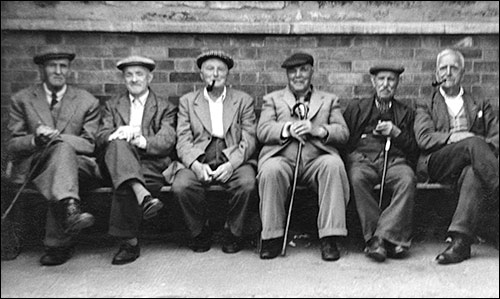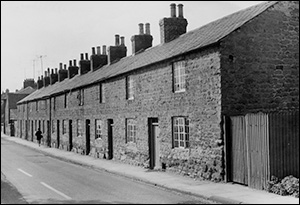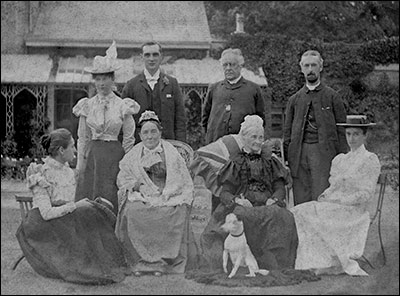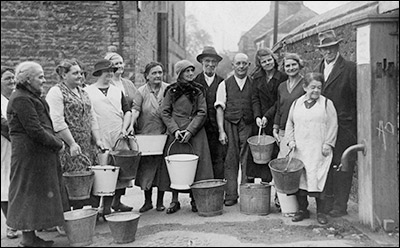| Original copy of a dictated account by Albert Granger, transcribed by Sally Crane |
|||||||||||
|
|||||||||||
|
Submitted for a competition in January 1958 |
|||||||||||
|
|||||||||||
|
I was born on February 9th in the year 1884 in Nichols Row, Church Street, Burton Latimer and was fifth in a family of 3 boys and 2 girls. I started school at the age of 3 years. The Church infants school was then where the big school is now but at that time it consisted of only two rooms. The old school was used for the older children. There was no playground then and we were sent to play in the old orchard at the back of the Rectory grounds. The field was so large and dotted with trees that we used to hide from the teachers and sometimes it was hours before we were coaxed back to lessons.
Mr Stalker was headmaster of the big school and Mrs Stalker headmistress of the infants. Mr Stalker died about 1891, and the children attended the funeral and sang at his graveside –
Mr Vickers followed Mr Stalker as headmaster. Mrs Stalker continued as headmistress but had to leave the school house and went to live in Cranford Road. We all left school at the age of 11 and on the last day were all taken to Stanion in a brake drawn by two horses to be examined. After having tea we came home and never went to school again whether we had passed or not. Before we started work we had to fetch a certificate from the Rector.
My mother used to go out washing for 1/- per day to Wallis’s Mill House and Downing’s Lodge. Quite often the ladies would give her something to bring home, once we had half a duck. A score of eggs sometimes with two or three duck eggs thrown in, cost 10d. A lb of butter cost 1/-, and coal was brought round on Saturday morning by Mr Turner for 10d a cwt. The Rev Bartlett was curate for Rev Newman and he used to wear a mortar board and he used to say “Church people would go to heaven like going on an express train, but the Chapel people would go on the luggage van.” He was a blunt man and used to laugh heartily. My mother was Church, and although my father worked for the Rector he was Chapel. Holidays were Good Friday and Christmas Day. We usually went to Church although we could go to Chapel sometimes if we liked. Miss Annie Newman daughter of the Rector used to play the organ and George Hickman who is still my old friend, was the blower. I belonged to the Church Temperance Society and a later curate Mr Priestland used to be leader and play the organ. His favourite hymn as “What has brought us here together.” Both the Church and Chapel had Sunday Schools. The Chapel had an attendance of 410 scholars in the Assembly Room and Lower School Room. Once when Mrs Newman heard that the Chapel had more Sunday School scholars than the Church she said, “I will soon alter that.” The Chapel always had its own Sunday School parades and tea parties. When the Rev Jacques came in 1895 the Church Sunday Schools used to parade and were provided with a banner. The Jacques like the Newmans were a wealthy family, and life at the Rectory was dept up in style with many servants, and the gardens were beautiful. Mr Collins was minister at the Baptist Chapel. The Wesleyan Chapel had not then been built and the Salvation Army held meetings in a cottage in Ambler’s Yard. Mrs Jacques and Mrs Collins used to sit in a little stone building at the bottom of Mr Nutt’s garden weekly to collect money from the village women who paid into a clothing club, amounts of between 3d and 1/- per week. The Club paid out in October. My mother one year bought a shawl for 5/-, but she was 1/6d short and had to pay this in full. The Church had a Mothers’ Meeting and women would start going to the Rectory at 1 o’clock in their white aprons and shawls. The last would still be going in at 3 o’clock as the first were coming away, so goodness knows how they conducted their meetings. There was no resident doctor. Dr Price of Kettering used to come over twice a week by horse and cart, and used to bring his own groom to hold the horse when he alighted. The first doctor to live in Burton was Dr Harris and he lived in an old farm house on the High Street where he had his surgery. He only had one eye and also had an impediment in his speech. There was no dentist, people either went to Kettering or Wellingborough, but there was a Mrs Roddis in Church Street who sold toothache essence for a penny, take your own bottle. The main entertainment was Burton Feast when the annual fair occupied the field on which now stands Pioneer Avenue. There used to be Thurston's Flying Horses at 1d a time and Blandies Ghost for 2d, also there was a boxing booth belonging to Mr Balls, but I was not allowed to see this. Local men would be invited to fight the champion. The Fair used to stay a week, and there would be a Band contest on the Saturday. De Mars used to hold plays in the Park as it was then, although it has now been built on. The principal play was “Maria Marten and the Red Barn”. General admission was 2d but if you wanted to sit in the front row it was 4d. The gentry of the day included Mr Harpur at the Hall, and Miss Harpur at Fern Bank, the Rector and the curate. Mr Sergeant who lived at the Laurels was a barrister and used to give us a penny if we touched our caps as he rode by in the street. Mr Preston of the Poplars was director of the ironstone pits. Sometimes when we were walking home from Kettering and he was leaving his office we would nimbly jump on the shafts of his brawn and have a ride. He would sometimes lash out with his whip, when we would grab it and tie it up. The Manor House was then let to several different people and was at one time the home of the curate - Mr Priestland. The Misses Orlebars related to the old family at Hinwick, lived in the old stone house in the High Street and built the Mission Room. Originally the village was run by the Rural District Council but later we had our own Parish Council and Mr Collins of the Chapel was chairman and there were 11 members. Mr Nutt was Clerk. They used to meet in the Chapel Lower School Room. The streets were originally lit with paraffin oil lamps and old Sam Henman used to climb up and light them and then slide down again. When gas was brought in I remember we used to sit round the workmen’s fire and roast potatoes. The first light was put in Mr James’s shop. The village was chiefly engaged in farming and ironstone mining. The principal farmers were Mr Harpur, Rev Newman, Mr Attfield, Mr Eady and Mr Barlow. There was hardly any industry. Whitney and Westleys started work in a little cottage in Finedon Street, opposite to their present factory. Mr James managed Wallis and Linnell’s factory and also ran a shop where the workers would buy their own oil and buttons if short on any garments. Later six old houses were pulled down and Hart and Levy’s factory built in Bakehouse Lane; their work used to come by rail. There were three flour mills on the river Ise – Wallis’s (now the Weetabix), Randalls (now a ruin) and Robinsons (burnt out in 1938). What we know as Station Road was then called Balls Lane and was only a cart track leading to Wallis’s Mill and Isham. Apart from six stone houses Amblers Cottage was the last on the High Street going South. There were no proper roads only muddy tracks and where there were pavements they were cobbled. Alexandra Street then only consisted of a little row of houses which stood on a cart track. There were many butchers and bakers and grocery shops and five public houses. They used to hold concerts in the Red Cow and many people would come away drunk at 10 o’clock. We were not allowed on the streets to see them. Thee was a brewery in Church Street owned by the Battle family of Cranford. Generations of the Blake family had the village smithy and in the winter horses would be taken there for what was called “turning up”. Where the Bank and post office now stand used to be an old thatched house belonging to Becky Warr who kept a shop there and would sell a farthing’s worth of sweets. And there was a selection!! You had to go down two steps to the door. The Council School now stands where once there was a beautiful garden and orchard. Water was obtained from the old pumps of Stockwell in Church Street, Boultons in Rock Terrace and one in Amblers Yard. People living south had theirs from a spring.
Mail was delivered at 7 o’clock in the morning and collected again at 6 o’clock in the evening by horse and cart when it would then carry on to Cranford. Mr John Moore ran the Post Office which was then in Church St. Most people going to Kettering if they did not want to walk, went by train and the fare was 2 ½ d single. The only paper was the Evening Telegraph and I used to collect these every evening at 6 o’clock from the Railway station. There were 12 regular customers and two who had to pay each time. I was paid 2 d for every dozen sold. There were two local characters “Deb Kersley” who used to smoke his pipe upside down and “Tinker Watts” who mended kettles. Many pedlars used to visit the village selling mohair laces 4 for a penny and Old Moore's Almanack for a penny, and pastries, jam tarts etc. Roving German bands used to come and play along the High Street. On May Day although it was not an official holiday they would not mind us being absent from school. We used to get up very early in the morning and go out into the fields and break branches off the trees and make flower garlands. The girls would be dressed in white. We used to sing:
We would go around the village knocking on the doors and singing, and would be given pennies and half pennies. At a given time we were to go to the Hall, the Rectory and fern Bank where pennies would be put in all our boxes. There was a murder committed in 1893 when Dick Sabey cut the throat of a local girl. He was brought through Burton in a horse and cart and put on the train at Kettering for Northampton where he was later tried and hung. Queen Victoria’s Diamond Jubilee in 1897 was celebrated with a big banner carrying the wording “Well played, 60 not out.” Burton was a cricket village and produced many good players. When the Boer War finished two local lads who returned, Jack Loake and Toddy Dent, were “chaired” round the village. When Queen Victoria died no one went to work – the Church bell tolled all day and there was a service in the afternoon. In those days there were many parties at Burton Latimer Hall, and at one Ball Miss Marion Harpur went dressed as Autumn. My mother used to assist with the preparations. There used to be a story that an underground passage from the Hall to the Manor House was once discovered. Someone went down but after travelling a little way came to an iron gate that could not be opened. |
|||||||||||



